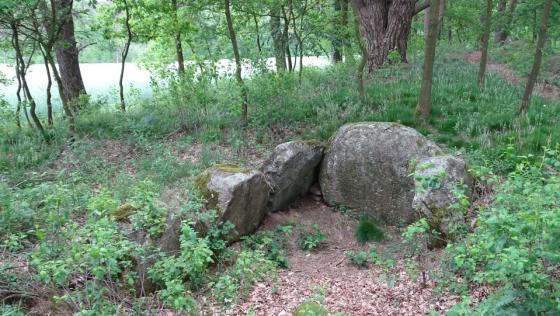taken from the on-site information board:
The stone cist tomb of Hagenah
The stone cist tomb of Hagenah belongs to a group of ruined burial mounds, which lay on a Geest ridge beside the valley of Schwingetal. Once the tomb rested under the southeastern edge of a mighty mound of about 26 meters in length, 22 meters wide and 1.80 m -2 meters high. Due to frequent sand removal this mound was mostly destroyed. According to reports, a 2.5 m x 3.5 m large stone packing was removed before 1930, the stone cist was discovered at the southeast end of the mound remnant. Only after finds from the burial chamber came to light, the then monument conservator in Stade, Adolf Cassau, was notified. To preserve the remains of the mound, he examined only the interior of the stone cist. He was supported by archeology doctoral candidate Karl Kersten from Stade, who later became widely known as a prehistorian. From the excavation findings and the reports of the sand-mining worker, the picture of a completely paved chamber resulted, in which probably two burials were made: A body burial and a burial of cremated bones are considered secured. The brozen grave goods, a so-called northern palstave, a two-part fibula and a dagger were assigned to the body burial (see found drawings and image of the finds on this board). The axe and the fibula belong to the period II of the Nordic Bronze Age after Montelius (some 1500 – 1250 BC).
The state of preservation of the monument required in 1964 an archaeological follow-up. Dr. J. Deichmüller uncovered the stone cist completely, so that its structure could be completely clarified: Two narrow, long support stones border the long side of the chamber. A larger and a second smaller support stone are on the western narrow side; on the eastern narrow side is a “closing stone”. A large capstone lies on the western chamber, a smaller cap covers the eastern third of the chamber. Several small stones close the gap between the two capstones. Very carefully, the joints between the support stones and capstones have been closed with hewn stones. Wedge stones provide good stability to the support stones embedded in the ground.
The History and Home Association of Stade has acquired the property with the stone cist to ensure the protection of this cultural monument from the older Bronze Age.





















